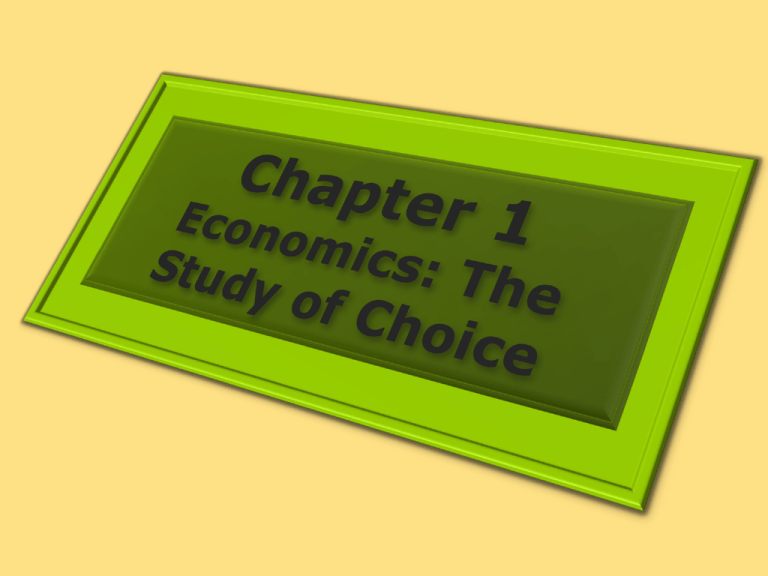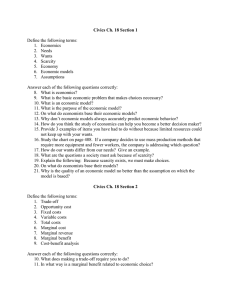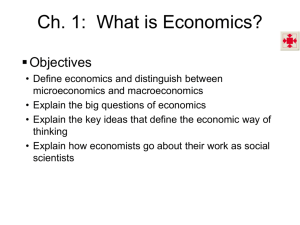
Economics
A social science that examines
how people choose among the
alternatives available to them
Scarcity:
When not enough is available for free to satisfy every
desired use…
Are Oranges in Tulare County Scarce??? A: Yes, B: No
Is your time scarce???
Scarcity, Choice, and Cost
•
Scarcity is the condition of having to
choose among alternatives.
• A scarce good is a good for which
the choice of one alternative requires
that another be given up.
• A free good is a good for which the
choice of one use does not require
that another be given up.
– e.g. when you use gravity it does
not prevent your neighbor from
using gravity.
Scarcity and the Fundamental
Economic Questions
•
•
•
What should be produced?
How should goods and services be produced?
For whom should goods and services be
produced?
Opportunity Cost
• The value of the best alternative
forgone in making any choice
Opportunity Cost
• The opportunity cost of a
good or service is its cost
in terms of the forgone
opportunity to pursue
the one best possible
alternative activity with
the same time or
resources
Copyright (c) Houghton Mifflin Company.
All rights reserved.
Your Daily Econ MANTRA
• Opportunity cost is:
The value of
the next best option.
Copyright (c) Houghton Mifflin Company.
All rights reserved.
7
Opportunity cost
• Examples: Opportunity costs for
College
– The tuition you pay to your college.
– The money you could have earned if you
spent your time working instead of
studying is also part of the opportunity cost
of a college education.
– The cost of meals that you eat while you
are in college is not part of the
opportunity cost of a college education,
because you would have to eat whether
you went to college or not.
2.1 The Economic Way of
Thinking
•
Distinguishing features between the economic
and the social science approach to choice:
• Economists give special emphasis to the role of
opportunity costs in their analysis of choices
• Economists assume that individuals make
choices that seek to maximize the value of some
objective
• Economists argue that individuals pay attention to
the consequences of small changes in the levels
of the activities they pursue
2.1 The Economic Way of
Thinking
•
Economists argue that an understanding of
opportunity cost is crucial to the examination of
choices
• Benefit of the economic way of thinking:
• It pushes us to think about the value of
alternatives in each problem involving choice
2.1 The Economic Way of
Thinking
•
A choice at the margin is a decision to do a little
more or a little less of something.
• The margin is the current level of an activity.
• The elements of opportunity cost, maximization, and
choices at the margin can be found in each of two
broad areas of economic analysis:
• Microeconomics
• Macroeconomics
2.2 Microeconomics and
Macroeconomics
•
•
Microeconomics is the branch of economics
that focuses on the choices made by
consumers and firms and the impacts those
choices have on individual markets.
Macroeconomics is the branch of economics
that focuses on the impact of choices on the
total, or aggregate, level of economic activity.
2.3 Putting Economics to
Work
•
Economics majors have a wide range of
employment opportunities.
• Careers
‒ Economists work in government, for
businesses, and in colleges and universities.
• Applying economics to other fields
‒ Undergraduate work in economics serves as
excellent preparation for law school.
‒ Average salary offers for economics majors
are among the highest across the disciplines.
3. THE ECONOMISTS’ TOOL
KIT
Learning Objectives
1. Explain how economists test hypotheses,
develop economic theories, and use models in
their analyses.
2. Explain how the all-other-things unchanged
(ceteris paribus) problem and the fallacy of
false cause affect the testing of economic
hypotheses and how economists try to
overcome these problems.
3. Distinguish between normative and positive
statements.
3. THE ECONOMISTS’ TOOL
KIT
• A variable is something whose value can
change.
• A constant is something whose value does
not change.
• The scientific method is a systematic set of
procedures through which knowledge is
created.
• A hypothesis is an assertion of a
relationship between two or more variables
that could be proven to be false.
3. THE ECONOMISTS’ TOOL
KIT
• A theory is a hypothesis that has not been
rejected after widespread testing and that
wins general acceptance.
• A law is a theory that has been subjected
to even more testing and that has won
virtually universal acceptance.
3.1 Models in Economics
• A model is a set of simplifying
assumptions about some aspect of the
real world.
– They help us understand the economy
and help us generate hypotheses about
the economy.
Key Terms:
• Ceteris Paribus: Latin term used
in Economics to mean “all other
things held constant.”
Δ : Delta; stands for “Change” or “Change in”
3.2 Testing Hypotheses in
Economics
• Hypotheses in economics specify a
relationship in which a change in one
variable causes another to change.
• A dependent variable is a variable that
responds to a change
• A independent variable is a variable
that induces a change.
3.2 Testing Hypotheses in
Economics
• Reaching the incorrect conclusion that one
event causes another because the two events
tend to occur together is called the fallacy of
false cause.
3.2 Testing Hypotheses in
Economics
• A positive statement is a statement of fact
or a hypotheses.
• A normative statement is a statement that
makes a value judgment.
Basic Graphing for Economics:
Graphing Convention:
X Axis = Horizontal line
Y Axis = Vertical line
Independent Variable = X
Dependent Variable = Y
Price, Wage,
Income, Earnings,
and Interest rate
are all PRICE
Except if PRICE is a variable.
In Economics,
PRICE is always Y
Clicker
The scale on the Y axis is
different than the scale on
the X axis.
A. That is just fine so long
as each axis keeps a
consistent scale
B. That is unacceptable;
scale must be the same
for both variables
C. What? What’s scale got
to do with anything
D. I’m totally lost.
Clicker:
The graph to the left
represents a
relationship that is:
A.Horizontal
B.Linear
C.Nonexistent
D.Nonlinear
E.Perpendicular
Calculate the Slope
Clicker:
The slope of the curve
R2 is:
A. 1
B. 10
C. 100
D. None of these
E. It cannot be
determined with the
information
available.
Clicker
The graph to the left
represents a
relationship that is:
A. Horizontal
B. Linear
C. Nonexistent
D. Nonlinear
E. Perpendicular









